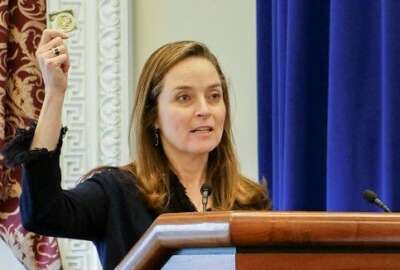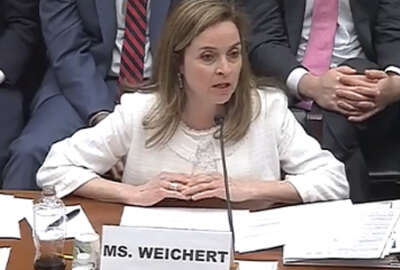

Amira Boland, who is coordinating the implementation of the Customer Experience Cross-Agency Priority Goal and the GEAR Center for OMB, and Jim Thompson. the...
Amira Boland, who is coordinating the implementation of the Customer Experience Cross-Agency Priority Goal and the GEAR Center for OMB, said the center is sending much needed energy and focus on challenges that, many times, don’t rise to the same level as those in technology, science and defense. But these back office areas, such as workforce retraining, customer service and data to decisions, can have a huge impact on agency success.

“People expect their interactions with the government to look like all their other interactions with entities. We need to be better at thinking about that and because we are thinking siloed in the agency itself instead of thinking about how our backstage process effecting our customer experience. People experience life events not federal agencies,” Boland said during a panel at the recent ACT-IAC Igniting Innovation Awards event, which also aired on Ask the CIO. “We are trying to convene agencies to think about how we are delivering services for an experience someone has not the way our statutory mission is written.”
The problem the GEAR Center is trying to solve is one that has been around for a long time.
Boland, who is an employee of the General Services Administration’s Office of Evaluation Sciences, said her office wanted to address challenges with promoting and training managers because too often agencies and organizations promoted employees with the best technical skills but not necessarily the best capabilities to be a successful manager.
“Google had actually noticed this because people were promoted there because of an amazing product development or they were an amazing engineer, and now they needed to lead an engineering team. They realized that they needed to double down on how they were doing their training of their managers,” Boland said. “We were looking at a project they had, called Project Oxygen, and we wanted to apply that for federal managers. It was really difficult because we had a team at Google that wanted to share what they had learned, and we had a team in government that really wanted to use what they had learned and adapted. It was hard for us to work together. The GEAR Center could be a neutral convening mechanism for us in government to toss our priorities to it and they can help convene the right players.”
She added that in the end GSA brought in the concepts around Project Oxygen, but only based on what was available publicly versus bringing in specific training from Google.
Too often, she said, the legal mechanisms and procurement process can be overwhelming when a program manager just wants some help with using data or thinking strategically. Agencies have a lot of options including interpersonal act agreements and co-sponsorship agreements along with challenges like the GEAR Center is using.
“We need people internally to be able to help translate that and help them along,” said Jim Thompson, the director of private sector engagement at the State Department. “That is kind of what my office does at the State Department, but we are one of a very few offices that even tries that.”
Thompson said program managers need training and support from the top to explore and use these other options to do work differently.
“Where we’ve seen public-private partnerships spike is when someone is tagged with building public-private partnerships,” he said.
State is one of those few agencies to have done that. The department launched Boldline, an accelerator for public-private partnerships, to create tools to address global challenges in November 2017.
“One of the things we do with our accelerator is ideas come in and we follow-up with all those organizations and we have touch points,” Thompson said. “We set up account managers with all these organizations so that we have some follow-up with them.”
Through Boldline, State brought in companies such as Facebook, Johnson & Johnson and Deloitte, who provided ideas that could be a public-private partnership.
“Facebook came to us with an idea around e-sports. We loved this idea. Facebook said e-sports is taking off all over the world but there are places in the world where people don’t know it or have the technology. They wanted to build a learning academy to train people on this. We said, ‘wow, that sounds like jobs, that sounds like economic opportunity.’ It sounds like something we would like to do ourselves,” Thompson said. “Facebook ended up pulling back from the project because of some of the challenges they have been having. But we established our own e-gaming program in the Middle East and we are looking to expand it. We love to take in ideas from the private sector because some of the best innovation will not come from government, but from outside government. We need to figure out a way to be open and allow ideas to come in.”
This is why vendors, universities and others need to do more to find those areas or topics that the government is seeking help on, Thompson added.
There are currently 29 opportunities on the Challenge.gov platform, ranging from phase 2 of NASA’s space robotics challenge to the Defense Department’s artificial intelligence applications to autonomous cybersecurity challenge to Interior Department’s effort to find the killer frog fungus.
Thompson said Boldline, GEAR and other similar efforts are trying to get agencies to think differently, take advantage of innovations and advances in the private sector and deliver services in a more holistic fashion.
Copyright © 2025 Federal News Network. All rights reserved. This website is not intended for users located within the European Economic Area.
Jason Miller is executive editor of Federal News Network and directs news coverage on the people, policy and programs of the federal government.
Follow @jmillerWFED


